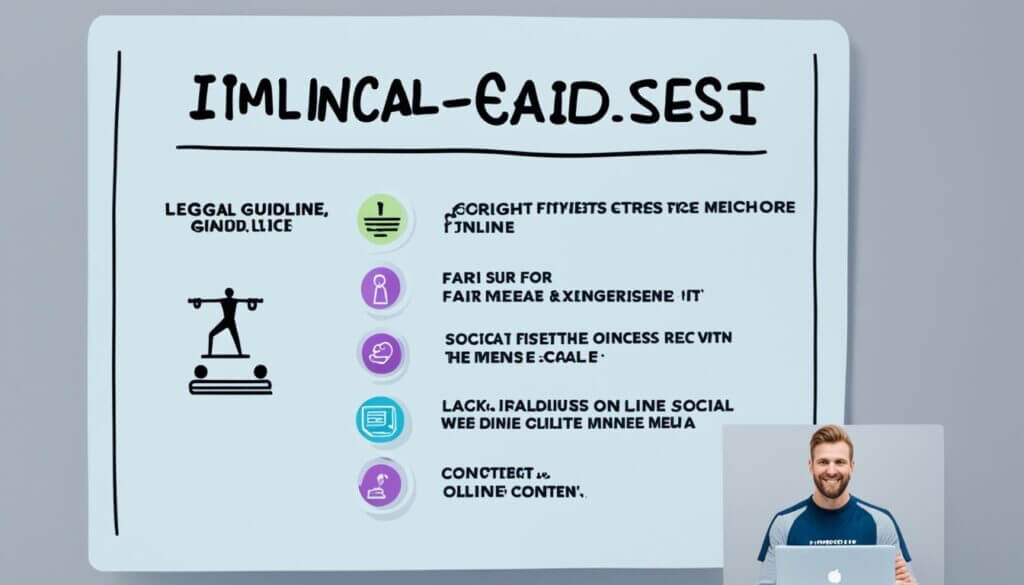Fair Use in Online Fitness Tutorials for Knee Health
Did you know that online fitness tutorials have experienced a significant surge in popularity over the past decade? With millions of people turning to these videos for guidance on maintaining knee health, it’s clear that they play a crucial role in promoting physical well-being. However, creators of these tutorials often encounter challenges when it comes to utilizing copyrighted material within the boundaries of fair use.
Key Takeaways:
- Fair use is a concept that allows the limited use of copyrighted material without permission or payment, under certain circumstances.
- Online fitness tutorials have become immensely popular for promoting knee health.
- Content creators must navigate the legal guidelines of fair use to incorporate copyrighted materials in their tutorials.
- Understanding the scope of fair use and adhering to best practices can help creators avoid copyright infringement risks.
- Responsible sharing and educational purposes are key principles that should guide online fitness tutorial creators.
Understanding Fair Use and Copyright Laws
In the realm of online fitness tutorials, it’s crucial to have a solid understanding of fair use and how it relates to copyright laws and intellectual property rights. Fair use is a legal doctrine that allows for the limited use of copyrighted material without seeking permission from the copyright holder. It provides a level of flexibility that enables content creators to incorporate existing works into their tutorials, fostering educational sharing and innovation.
Fair use is not an absolute right, but rather a balance between the rights of copyright owners and the public interest in accessing and using creative works. It is guided by a set of principles outlined in copyright laws, which vary from country to country. These laws define the scope of fair use and establish the criteria that determine whether a particular use is considered fair or infringing.
“Fair use is the right to use portions of copyrighted materials without permission for purposes such as criticism, commentary, news reporting, teaching, scholarship, or research.”
– U.S. Copyright Office
To determine if a specific use qualifies as fair use, courts typically consider the purpose and character of the use, the nature of the copyrighted work, the amount and substantiality of the portion used, and the effect of the use on the potential market or value of the original work. These factors help assess whether the use is transformative, non-commercial, or educational in nature, and whether it meets the overall test of fairness.
The fair use doctrine serves as a crucial mechanism for fostering creativity, innovation, and the free flow of ideas. It allows content creators in the fitness industry to draw inspiration from existing resources without infringing on copyright holders’ exclusive rights. By understanding the fundamentals of fair use and copyright laws, fitness instructors can navigate the legal landscape with confidence, ensuring they respect intellectual property rights while creating engaging and informative tutorials.

Key Points:
- Fair use is a legal doctrine that enables the limited use of copyrighted material without seeking permission.
- It is guided by principles outlined in copyright laws, which vary by country.
- Courts consider factors such as the purpose, nature, amount, and effect of the use to determine if it qualifies as fair use.
- Understanding fair use allows content creators to incorporate existing works into their tutorials while respecting intellectual property rights.
Legal Guidelines for Online Fitness Tutorials
Instructors of online fitness tutorials must adhere to specific legal guidelines when incorporating copyrighted content. These guidelines ensure that content creators use materials for educational purposes while staying within the boundaries of fair use.
Key Legal Guidelines for Online Fitness Tutorials
1. Educational Purpose: Content creators should primarily use copyrighted materials in their online fitness tutorials for educational purposes. This includes providing instructional guidance, offering tips, and sharing knowledge related to knee health.
2. Fair Use Analysis: Before incorporating copyrighted content, instructors should conduct a fair use analysis to determine if their use qualifies as fair use. This analysis considers the purpose and character of the use, the nature of the copyrighted work, the amount used, and the effect on the market.
3. Attribution: It is crucial for instructors to give proper attribution to the original copyright holders. This involves clearly identifying the source of the copyrighted material and acknowledging the creator or owner of the content.
4. Permission: In some cases, instructors may need to seek permission from copyright owners to use their materials in online fitness tutorials. This is particularly important when using substantial portions of copyrighted works.
5. Public Domain and Creative Commons: Content creators should consider using materials that are in the public domain or licensed under Creative Commons. These sources often offer freedom to use the content without specific permissions or restrictions.
Instructors must remember that legal guidelines are in place to protect intellectual property rights and foster a responsible approach to online fitness tutorials. By following these guidelines, content creators can ensure that their tutorials remain informative, engaging, and legally compliant.
For a better understanding of how to navigate legal guidelines, refer to the table below:
| Legal Guideline | Description |
|---|---|
| Educational Purpose | Using copyrighted materials primarily for educational purposes in online fitness tutorials. |
| Fair Use Analysis | Conducting a fair use analysis to determine if the use of copyrighted content qualifies as fair use. |
| Attribution | Giving proper credit and acknowledging the original copyright holders. |
| Permission | Seeking permission from copyright owners to use their materials in online fitness tutorials. |
| Public Domain and Creative Commons | Considering materials that are in the public domain or licensed under Creative Commons for unrestricted use. |
By following these legal guidelines, instructors can create online fitness tutorials that are both informative and legally compliant.

The Scope of Fair Use in Online Fitness Tutorials
In the realm of online fitness tutorials, fair use allows content creators to incorporate various types of content, such as exercise videos and instructional materials, within the limits of the law. This section will explore the scope of fair use specifically in the context of promoting knee health through online fitness tutorials.
Exercise videos play a vital role in online fitness tutorials, providing visual demonstrations of different workouts and techniques. By utilizing exercise videos, instructors can effectively guide viewers through proper form and sequences, enhancing their understanding of knee health exercises.
Furthermore, instructional materials, such as diagrams and illustrations, can be incorporated to complement the exercise videos. These materials can visually explain the benefits and techniques of specific exercises, empowering viewers to engage in knee-friendly workouts.
“Integrating exercise videos and instructional materials within the framework of fair use enables online fitness instructors to create engaging and informative tutorials, promoting knee health effectively.”
It is important to note that fair use has its limitations. While utilizing exercise videos and instructional materials is permissible under fair use, the content must be used for educational purposes and not for profit. Additionally, the amount and substantiality of the content used should be appropriate and not exceed what is necessary to convey the intended educational message.
By understanding the scope of fair use, online fitness instructors can confidently create engaging tutorials that prioritize knee health while respecting copyright laws.
Stay tuned for the next section, where we will compare fair use with fair dealing, shedding light on their similarities and differences in the context of copyright laws.
Fair Use vs. Fair Dealing: A Comparative Analysis
In some jurisdictions, the concept of fair dealing is similar to fair use in terms of its aim to strike a balance between copyright owners’ rights and the public’s interest in accessing and using copyrighted materials. However, there are significant differences between the two, which we will explore in this section.
While fair use is a doctrine under U.S. copyright law, fair dealing is primarily found in common law systems, such as those in the United Kingdom, Canada, Australia, and other Commonwealth countries. Both fair use and fair dealing allow the use of copyrighted materials without permission from the copyright holder, but the scope and limitations of these doctrines may vary.
One notable distinction between fair use and fair dealing is the purpose and nature of the use. Fair use in the United States places emphasis on transformative use, where the copyrighted material is utilized in a new or different context, often for criticism, commentary, or educational purposes. On the other hand, fair dealing in common law jurisdictions typically has specific statutory exceptions for educational or research purposes.
“Fair use and fair dealing are both legal doctrines that enable the use of copyrighted material without permission from the copyright owner. While they have similar goals, they have distinct scopes and qualifications.”
Another significant difference lies in the factors considered when determining fair use or fair dealing. In the United States, fair use is guided by four factors: the purpose and character of the use, the nature of the copyrighted work, the amount and substantiality of the portion used, and the effect of the use on the market for the original work. Fair dealing, on the other hand, varies by jurisdiction and may consider factors such as the nature of the work, the extent of the use, and the effect on the market.
It’s important to note that fair use and fair dealing operate within the framework of copyright laws, which differ in various countries. Content creators and users should be aware of the specific laws and regulations in their jurisdiction to ensure compliance and avoid copyright infringement.
Comparing Fair Use and Fair Dealing
| Fair Use | Fair Dealing | |
|---|---|---|
| Purpose of use | Transformative: criticism, commentary, education | Specific statutory exceptions (e.g., research, education) |
| Factors considered | 4 factors (purpose, nature, amount, effect on market) | Vary by jurisdiction (e.g., nature, extent, effect on market) |
| Jurisdictions | United States | Common law systems (e.g., UK, Canada, Australia) |
Understanding the similarities and differences between fair use and fair dealing is essential for content creators and users alike. By staying informed about the legal frameworks in their respective jurisdictions, individuals can navigate copyright laws responsibly, ensuring they comply with the regulations while promoting educational sharing and creativity.
Challenges and Risks in Using Copyrighted Material
When creating online fitness tutorials that promote knee health, content creators often encounter challenges and risks associated with using copyrighted material. It is crucial to understand these obstacles and take proactive measures to mitigate potential legal issues.
1. Copyright Infringement Concerns:
One of the primary risks of incorporating copyrighted material without proper authorization is copyright infringement. Unauthorized use of copyrighted images, videos, or music can result in legal actions, including takedown notices, monetary damages, and even lawsuits.
2. Lack of Clear Fair Use Guidelines:
The boundaries of fair use can be subjective and vary depending on the jurisdiction. Determining what constitutes fair use in the context of online fitness tutorials can be challenging as there is no comprehensive set of guidelines. Content creators must navigate this gray area cautiously.
3. Complex Copyright Laws:
Copyright laws can be intricate and overwhelming to understand. They differ across countries, making it difficult for content creators to ensure compliance when their audience spans various jurisdictions. Failing to adhere to specific legal requirements can lead to legal consequences.
4. Misunderstanding Attribution Requirements:
Many content creators underestimate the importance of proper attribution for copyrighted material. Failure to attribute the original authors or sources can not only harm the reputation of the tutorial but also result in accusations of plagiarism or copyright violations.
5. Limited Availability of Royalty-Free Content:
Finding high-quality royalty-free content that suits the needs of the tutorial can be a time-consuming task. The limited availability of such materials may tempt content creators to use copyrighted content without authorization, exposing themselves to legal risks.
6. Increased Scrutiny and Copyright Enforcement:
As the digital landscape evolves, copyright enforcement has become more vigilant. Content creators face increased scrutiny from copyright holders and organizations that actively monitor and pursue instances of copyright infringement. This heightens the risks associated with using copyrighted material without permission.
To overcome these challenges and minimize the risks, content creators should prioritize the following:
- Obtain proper authorization or licenses for copyrighted material.
- Seek legal counsel to understand fair use and copyright laws specific to their jurisdiction.
- Give due credit and proper attribution to the original authors or sources of copyrighted material.
- Utilize royalty-free content or obtain permissions from copyright holders.
- Stay updated with the latest developments in copyright laws and enforcement practices.
By proactively addressing these challenges and adopting responsible practices, content creators can minimize legal risks, protect their intellectual property, and ensure the longevity of their online fitness tutorials promoting knee health.
Best Practices for Respecting Copyright in Online Fitness Tutorials
Creating engaging and informative online fitness tutorials requires content creators to be mindful of copyright laws. By taking the necessary steps to respect intellectual property rights, you can ensure the legality and integrity of your tutorials while promoting knee health. Here are some best practices to follow:
1. Seek Permission
When using copyrighted materials such as images, music, or video clips in your online fitness tutorials, it is essential to obtain proper permission from the copyright holders. This can be done by reaching out to the creators directly or through licensing platforms. Obtaining permission ensures that you are legally using the content and avoids potential copyright infringement issues.
2. Give Proper Attribution
Always attribute the original creators of the copyrighted materials used in your tutorials. Provide clear and visible credits, including the name of the creator and the source of the content. Proper attribution not only respects copyright laws but also acknowledges the hard work and talent of the original artists or authors.
3. Use Public Domain or Creative Commons-Licensed Materials
Public domain or Creative Commons-licensed materials can be used in your online fitness tutorials without seeking permission, as long as you comply with the licensing terms. Public domain materials are not protected by copyright and can be freely used by anyone. Creative Commons licenses allow creators to share their work under specific conditions, such as giving attribution or using the content for non-commercial purposes. Be sure to understand and adhere to the terms of these licenses to avoid any legal issues.
4. Create Your Own Original Content
One of the best ways to avoid copyright infringement is by creating your own original content for your online fitness tutorials. By using your expertise and creativity, you can develop unique exercises, demonstrations, and instructional materials. Original content not only guarantees that you are the sole copyright holder but also adds value and authenticity to your tutorials.
“Respecting copyright laws in online fitness tutorials is not only a legal obligation but also an ethical responsibility. By following these best practices, content creators can ensure that their tutorials contribute positively to the fitness community while promoting knee health.”
| Best Practices for Respecting Copyright in Online Fitness Tutorials |
|---|
| 1. Seek permission from copyright holders. |
| 2. Give proper attribution to original creators. |
| 3. Use public domain or Creative Commons-licensed materials. |
| 4. Create your own original content. |
Conclusion
Throughout this article, we have explored the significance of fair use in the context of online fitness tutorials for promoting knee health. We have learned that fair use allows content creators to incorporate copyrighted materials within certain limitations, ensuring a balance between educational sharing and respecting intellectual property rights.
By understanding the legal guidelines and scope of fair use, online fitness instructors can create engaging and informative tutorials that incorporate exercise videos, instructional materials, and other relevant content. It is crucial to exercise caution and adhere to copyright laws to avoid potential challenges and risks associated with using copyrighted material.
We have also discussed the comparison between fair use and fair dealing, highlighting their similarities and differences. While fair dealing applies in certain jurisdictions, fair use provides a broader scope of flexibility in the United States.
As content creators, it is vital to adopt best practices for respecting copyright in online fitness tutorials. This includes seeking permission, giving proper attribution, and utilizing public domain or creative commons-licensed materials whenever possible. By doing so, we can navigate copyright laws responsibly and contribute to the growth of educational sharing while promoting knee health and overall wellness.
FAQ
What is fair use?
Fair use is a legal principle that allows for the limited use of copyrighted materials without the permission of the copyright owner. It is based on the notion that certain uses of copyrighted content, such as for criticism, commentary, research, or teaching, can be considered fair and do not infringe upon the copyright holder’s rights.
How does fair use apply to online fitness tutorials for knee health?
Fair use can be applied to online fitness tutorials for knee health when instructors incorporate copyrighted materials, such as exercise videos or instructional materials, for educational purposes. However, it is essential to stay within the boundaries of fair use and ensure that the amount used is reasonable and does not negatively impact the market for the copyrighted work.
What are the legal guidelines for using copyrighted content in online fitness tutorials?
Content creators of online fitness tutorials should adhere to certain legal guidelines when using copyrighted materials. These guidelines include using the content for educational purposes, providing proper attribution, seeking permission when necessary, and ensuring that the use of the copyrighted material does not harm the market value of the original work.
What types of content can be used within the scope of fair use in online fitness tutorials?
Within the scope of fair use, content creators of online fitness tutorials can use various types of copyrighted content. This includes exercise videos, instructional materials, images, and short clips, as long as the use is transformative, adds educational value, and does not infringe upon the rights of the original copyright owner.
What is the difference between fair use and fair dealing?
Fair use and fair dealing are similar concepts, but they differ in application and legal jurisdictions. Fair use is primarily used in the United States, allowing for the limited use of copyrighted materials without permission. Fair dealing is a term used in some other jurisdictions, but it also allows for specific uses of copyrighted works for purposes such as research, private study, reporting, or criticism, with varying criteria and limitations.
What are the challenges and risks associated with using copyrighted material in online fitness tutorials?
Using copyrighted material in online fitness tutorials comes with potential challenges and risks. One main risk is the possibility of copyright infringement if the use exceeds the limits of fair use. Content creators may also face legal consequences, such as lawsuits or takedown requests, especially if their use of copyrighted material harms the market value of the original work.
What are the best practices for respecting copyright in online fitness tutorials?
Content creators can follow several best practices to respect copyright laws in online fitness tutorials. These practices include seeking permission from the copyright owner when necessary, properly attributing the sources of copyrighted material used, using public domain or creative commons-licensed materials where possible, and always ensuring that the use is for educational purposes and falls within the limits of fair use.







